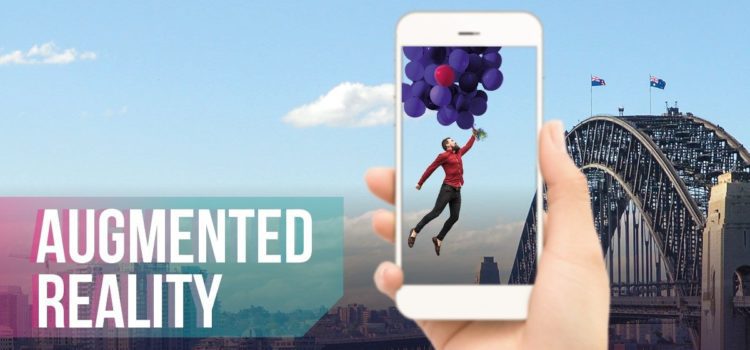Unlocking Your Potential: Augmented Reality in Business

In our fast-changing tech world, Augmented Reality in business is a big deal that’s changing how businesses connect with customers. To understand why it’s important, just think about this: In the U.S., there are a massive 68.7 million people using AR every month. But let’s start with the basics: What exactly is AR?
AR, short for Augmented Reality, mixes the real world with digital info in real-time, creating a mix of the physical and digital in your surroundings. People often get AR confused with its close relative, Virtual Reality (VR), because they both combine real life and digital things. But AR works in your real environment, adding new info, while VR puts you completely in a digital world.
Augmented Reality in marketing, for example, is changing how businesses interact with customers, train their employees, and develop new ideas. Organizations, from stores to car companies, are using AR and Virtual Reality (VR) to work better and be more creative. Real estate companies and retail stores can create VR-powered virtual tours of their properties or stores. This gives potential customers an immersive experience and helps them decide about visiting or purchasing.
Web AR technology is already used in Live Events, Retail, Healthcare, Video Entertainment, Military, Engineering, and Real Estate. Its potential is huge, and more industries are starting to use it.

Source: Woodside Capital Research
The Rise of Augmented Reality E-commerce
The AR/VR market is predicted to reach an impressive $114.5 billion by 2027, and augmented reality in ecommerce plays a significant role, with 77% of customers preferring to use augmented reality capabilities to preview product variations. Industry experts credit this growth to advancements in 5G technology, artificial intelligence, and robotics, which are driving AR’s popularity. Looking ahead to 2025, web technology examples give us more valuable insights into how this technology is evolving.
Video Games: $11.6 billion
Healthcare: $5.1 billion
Engineering: $4.7 billion
Live Events: $4.1 billion
Entertainment: $3.2 billion
Real Estate: $2.6 billion
Retail: $1.6 billion

Source: Brian Wallace of Hackernoon
AR offers a wide variety of uses that often fly under the radar. Chances are, you’ve come across AR without realizing it. It’s not just about understanding augmented reality business intelligence; it’s also about using it effectively.
One of AR’s powerful applications is turning any smartphone or tablet into an interactive shopping tool, whether you’re online or in a physical store. AR technology in business provides immersive shopping experiences, enabling customers to virtually test products before purchasing.This transformation of shopping is reshaping the way we buy products and enhancing the overall customer experience.
AR also empowers field engineers with real-time remote assistance through smart glasses, which are like high-tech eyewear. This technology enhances safety by providing immediate support, reduces confusion during complex tasks, and connects experts from around the world.
The ability to access expert guidance and information right in their field of view allows field engineers to work more effectively and make better-informed decisions, ultimately benefiting both the workers and the organizations they serve.
Advantages of Augmented Reality in Business
Augmented Reality (AR) isn’t just tech terminology; it’s a game-changer with many advantages for different industries. These web technology examples show how AR is changing the way we work, learn, and explore. Let’s take a closer look at the benefits AR brings to businesses and more. Understanding AR’s potential is crucial. AR is gaining traction in various sectors:
Retail
AR turns smartphones and tablets into shopping platforms, enhancing the in-store or online experience. Customers can virtually try products, reducing returns and boosting satisfaction.
Industrial Field Services
AR, like Fieldbit’s solution, empowers field engineers with real-time remote assistance using AR smart glasses. Experts can overlay instructions on the engineer’s view, improving safety and efficiency.
Design and Modeling
Companies like Augment enable designers to visualize product prototypes in AR, facilitating cost-effective product development and design comparisons.
Training and Education
AR is transforming medical education, allowing students to explore 3D holographic anatomy. AR enhances training across various fields by offering immersive, effective learning experiences.
Travel and Tourism
GPS mobile apps with AR features provide tourists with interactive routes, translations, and cultural experiences, enhancing navigation apps.
Repair and Maintenance
Hyundai’s AR owner’s manual simplifies car maintenance for consumers. AR overlays guide users through repairs, reducing downtime and improving customer satisfaction.
Augmented reality technology is becoming a stronger force in advertising, and AR serves as a gateway to engage users and elevate your brand. Much like how personalization transformed the eCommerce landscape, AR is a game-changer for the retail sector. Virtual fitting rooms and AR advertisements are just the beginning; the potential applications of AR are boundless.
Augmented Reality in Business: A Conclusion to Transformative Change
Augmented Reality isn’t some distant concept of the future; it’s here, actively reshaping businesses across various industries. AR is more than just a tool; it’s a catalyst for engagement, innovation, and growth. The moment is ripe to seamlessly integrate AR into your business strategy.
Are You Ready to Dive into the World of AR? Schedule a Meeting with Our Marketing Experts Today!

